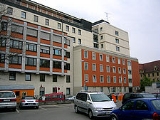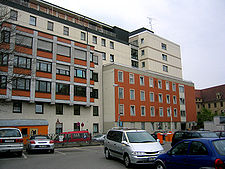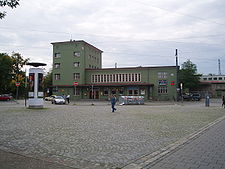
Augsburg-Oberhausen
Encyclopedia
Oberhausen is one of the seventeen Planungsräume (English: Planning district, singular Planungsraum) of Augsburg
, Bavaria
, Germany
. Located in the northwestern portion of the city, it is home to 23,510 residents as of January 1, 2006, making it one of the larger planning districts in terms of population. Contained within Oberhausen are five Stadtbezirke (English: ward, singular Stadtbezirk.) The second largest river in Augsburg, the Wertach River
, flows through Oberhausen.
, the largest river in Augsburg. Oberhausen is bordered on the west by the Bärenkeller
and Kriegshaber Planning districts. The district's northern border is the municipal limit of Augsburg, and the southern border is with the Innenstadt planning district, and the two are separated by a railway line.
 Oberhausen is a multicultural district which has the highest proportion of residents of foreign origin in Augsburg. Due to the high number of immigrant and foreign residents and their families, Oberhausen has a very low median age compared to other sections of Augsburg. In the southern portion of Oberhausen along the right bank of the Wertach River is a large Assyrian
Oberhausen is a multicultural district which has the highest proportion of residents of foreign origin in Augsburg. Due to the high number of immigrant and foreign residents and their families, Oberhausen has a very low median age compared to other sections of Augsburg. In the southern portion of Oberhausen along the right bank of the Wertach River is a large Assyrian
community, whereas the largest concentration of Turkish
residents is found along the river's left bank. The northern portion of Oberhausen is the location of Augsburg's Russian community. Oberhausen has combined these foreign influences and retains an air of a smaller city. Other portions of Oberhausen are characterized by a stark difference between types of development even over very small distances. Despite the small town atmosphere, Donauwörther Street is Augsburg's red light district
, with two sanctioned brothel
s. However, the Josefinum, built in 1902, is one of Germany's largest children's hospitals.
Due to its multicultural nature, Oberhausen is home to many cultural associations, such as the German-Thai
peoples' society, the Chinese
-German association, and others. As is normal with such areas of cities, Oberhausen is home to its own sport clubs, however, many of these clubs are ethnically themed.
 Donauwörther Street is Oberhausen's main north-south oriented street, whereas Ulmer Street is the main east-west route. Oberhausen has its own train station, and most trains which approach Augsburg from the north or west will stop in Oberhausen. Oberhausen is connected to the downtown area with two tram
Donauwörther Street is Oberhausen's main north-south oriented street, whereas Ulmer Street is the main east-west route. Oberhausen has its own train station, and most trains which approach Augsburg from the north or west will stop in Oberhausen. Oberhausen is connected to the downtown area with two tram
lines, the numbers 2 and 4.
Augsburg
Augsburg is a city in the south-west of Bavaria, Germany. It is a university town and home of the Regierungsbezirk Schwaben and the Bezirk Schwaben. Augsburg is an urban district and home to the institutions of the Landkreis Augsburg. It is, as of 2008, the third-largest city in Bavaria with a...
, Bavaria
Bavaria
Bavaria, formally the Free State of Bavaria is a state of Germany, located in the southeast of Germany. With an area of , it is the largest state by area, forming almost 20% of the total land area of Germany...
, Germany
Germany
Germany , officially the Federal Republic of Germany , is a federal parliamentary republic in Europe. The country consists of 16 states while the capital and largest city is Berlin. Germany covers an area of 357,021 km2 and has a largely temperate seasonal climate...
. Located in the northwestern portion of the city, it is home to 23,510 residents as of January 1, 2006, making it one of the larger planning districts in terms of population. Contained within Oberhausen are five Stadtbezirke (English: ward, singular Stadtbezirk.) The second largest river in Augsburg, the Wertach River
Wertach River
The Wertach is a river in Bavaria, southern Germany, left tributary of the Lech. Its total length is 151 km. The Wertach originates in the Northern Limestone Alps, in Bad Hindelang, east of Sonthofen . It flows north along the towns Wertach, Nesselwang, Marktoberdorf, Kaufbeuren, Schwabmünchen and...
, flows through Oberhausen.
Location
Oberhausen is bordered on the east by the Lech RiverLech River
The Lech is a river in Austria and Germany. It is a right tributary of the Danube in length with a drainage basin of .Its source is located in the Austrian state of Vorarlberg, where the river rises from lake Formarinsee in the Alps at an altitude of...
, the largest river in Augsburg. Oberhausen is bordered on the west by the Bärenkeller
Augsburg-Bärenkeller
Bärenkeller is one of the seventeen highest level civic divisions, or Planungsräume , of the city of Augsburg, Bavaria, Germany. It is located in the northwestern portion of the city and consists of only one Stadtbezirk, or ward, 23 Bärenkeller, with which it is coterminous...
and Kriegshaber Planning districts. The district's northern border is the municipal limit of Augsburg, and the southern border is with the Innenstadt planning district, and the two are separated by a railway line.
Characterization

Assyrian people
The Assyrian people are a distinct ethnic group whose origins lie in ancient Mesopotamia...
community, whereas the largest concentration of Turkish
Turkish people
Turkish people, also known as the "Turks" , are an ethnic group primarily living in Turkey and in the former lands of the Ottoman Empire where Turkish minorities had been established in Bulgaria, Cyprus, Bosnia and Herzegovina, Georgia, Greece, Kosovo, Macedonia, and Romania...
residents is found along the river's left bank. The northern portion of Oberhausen is the location of Augsburg's Russian community. Oberhausen has combined these foreign influences and retains an air of a smaller city. Other portions of Oberhausen are characterized by a stark difference between types of development even over very small distances. Despite the small town atmosphere, Donauwörther Street is Augsburg's red light district
Red Light District
Red Light District may refer to:* Red-light district - a neighborhood where prostitution is common* The Red Light District - the title of the 2004 album by rapper Ludacris* Red Light District Video - a pornography studio based in Los Angeles, California...
, with two sanctioned brothel
Brothel
Brothels are business establishments where patrons can engage in sexual activities with prostitutes. Brothels are known under a variety of names, including bordello, cathouse, knocking shop, whorehouse, strumpet house, sporting house, house of ill repute, house of prostitution, and bawdy house...
s. However, the Josefinum, built in 1902, is one of Germany's largest children's hospitals.
Due to its multicultural nature, Oberhausen is home to many cultural associations, such as the German-Thai
Thai people
The Thai people, or Siamese, are the main ethnic group of Thailand and are part of the larger Tai ethnolinguistic peoples found in Thailand and adjacent countries in Southeast Asia as well as southern China. Their language is the Thai language, which is classified as part of the Kradai family of...
peoples' society, the Chinese
Chinese people
The term Chinese people may refer to any of the following:*People with Han Chinese ethnicity ....
-German association, and others. As is normal with such areas of cities, Oberhausen is home to its own sport clubs, however, many of these clubs are ethnically themed.
Transportation

Tram
A tram is a passenger rail vehicle which runs on tracks along public urban streets and also sometimes on separate rights of way. It may also run between cities and/or towns , and/or partially grade separated even in the cities...
lines, the numbers 2 and 4.

